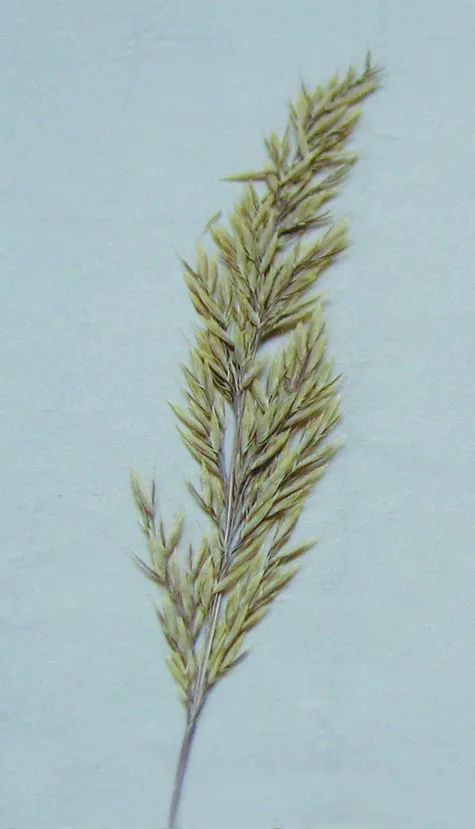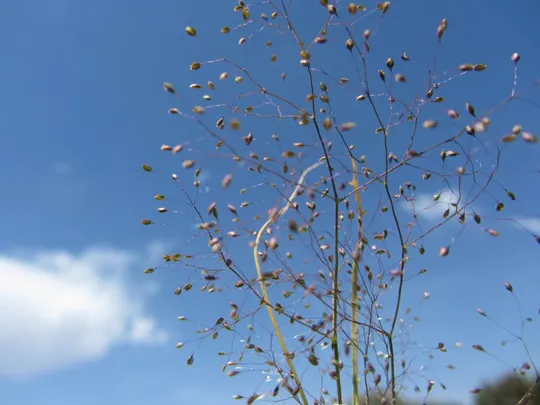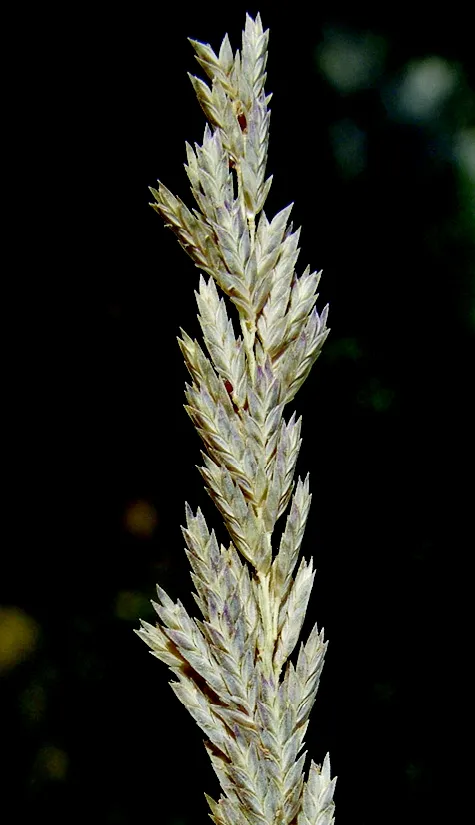Michelii Oat Grass
Trisetaria michelii

Trisetaria michelii is an
erect annual herb, 5-12 cm tall. The stem and leaves are covered with
dense soft hairs. The leaf is flat and gradually narrows as occurs in many
Poaceae. The papery ligule is minute (1 mm). The inflorescence is a
dense cylindrical panicle, similar to those of many Poaceae.
When in flower the panicle opens and spreads, but immediately
afterwards as it ripens, it closes again and looks like a spike. The
basic inflorescence unit, the spikelet, has 2-4 florets with awns
growing on the palea. The flowers are far apart. The lower glume is
narrow and short, about a quarter of the length of the
upper glume. The lemma of each floret has two subulate teeth and
an awn in the in the gap between the teeth (the last two features
are unique to the genus Avellinia). T. michelii blooms in
April, and is wind-pollinated. Self-pollination probably occurs.
Grows on the Coastal Plain: in the Acre Valley (Liman Nature Reserve) and in the Philistean Plain (Gedera and Kiryat Ono קרית אונו לא נמצאת ב"פלשת"). There is a record of the species from the Gehah Junction in the 1990s. Attempts to find the plant recently in Kiryat Ono and Gehah Junction were unsuccessful (Shir Vered, 2005).
Avellinia michelii populations in the country are both peripheral and fragmented.
shallow Hamra, Husmas (layer of soil above rocks in the gravel found in the Coastal Plain) and brittle calcareous sandstone covered with Hamra or sandy soil on the Coastal Plain. Outside of Israel the species does not necessarily grow in sandy habitats. For example: the type specimen was collected on limestone slopes in Italy; in Cyprus it grows in Mediterranean garigues on limestone at an altitude of 300 meters.
the species was once considered a separate genus named Avellinia, but was recently merged with the genus Trisetaria .
Avellinia was a monotypic genus, growing around the Mediterranean Basin from Portugal and Morocco in the west to Greece and Cyprus in the east. It included 1-2 species (i.e. the two close species could be one taxon with two subspecies). The genus Avellinia is close to the genus Rostraria, and in the distant past was considereda species of this genus.
• The rapid development of the Coastal Plain has destroyed most of the Hamra, calcareous sandston and Hosms habitats. All the sites are close to settlements and agricultural fields. The Gedera site that is extinct (possibly a renewing population will be discovered nearby) and the Kiryat Ono site, on which a residential area will be built are in fact located within an urban area. The Liman Nature Reserve is situated near a main highway and suffers from vehicle emissions and from the effects of chemical spraying of surrounding fields.
• The plant is located in three different regions along the Coastal Plain, in disjunct sites tens of kilometers apart.
• The Liman Nature Reserve population in the Western Galilee was only discovered and counted in 1997; 20 individuals were counted in a 20 sq.m. Patch. The population existed in the same order of magnitude in 1998 and 2000. In Kiryat Ono the species apparently became extinct as a result of construction on the site (2005).
• In Israel the plant is very rare and on the verge of extinction, but is not apparently globally threatened. Over the last century the species has expanded its range in Europe and moved northwards (as do many annuals that spread in the wake of human cultivation or as a result of global warming).
• The plant is currently protected only in the Liman Nature Reserve.
To monitor the species populations in the Liman Nature Reserve; to rescue the plant population in Kiryat Ono and to naturalize it in the other Hamra reserves on the Coastal Plain.
Around the Mediterranean Basin: Portugal, Southern France, Italy, Yugoslavia, Greece, Crete, Turkey, Cyprus, Morocco and Algeria. Interestingly it does not grow in Lebanon.
An annual plant unique to Hamra, calcareous sandstone and Husmas soils on Israel’s Coastal Plain that is very difficult to identify. Currently known on from two sites (the Liman Nature Reserve and Kiryat Ono), and the past was also observed in Gedera (1927). Construction at the Kiryat Ono site began in 2000. A seriously threatened red plant: it is peripheral and its habitat is being constantly destroyed. The surviving populations are small and fragmented. The Liman Nature Reserve populations should be monitored; an effort should be made to preserve the Kiryat Ono site and to consider naturalizing it on additional Hamra reserves on the Coastal Plain.
פרגמן, א., שמידע, א., רבינוביץ, א., שמיר, צ. ווולצ'ק, מ. 1995. ילקוט הצמחים הנדירים הפוטנציאלים של עמק-עכו והגלבוע. רשות הטבע והגנים, החברה להגנת הטבע ורת"ם – מרכז המידע לצמחי ישראל.
Current Occupancy Map
| 1000 squre meter pixel | 5000 squre meter pixel | 10000 squre meter pixel | |
|---|---|---|---|
| number of observations | 0 | 0 | 0 |
| in total pixels | 0 | 0 | 0 |
| Family | Gramineae |
| Classification | On the endangered species list |
| Ecosystem | Coastal Area |
| Chorotype | Mediterranean |
| Conservation Site | Liman Nature Reserve |
| Rarity |
1
5
6
|
|---|---|
| Vulnerability |
0
4
4
|
| Attractiveness |
0
0
4
|
| Endemism |
0
0
4
|
| Red number |
1
5.3
10
|
| Peripherality | N |
| IUCN category | DD EW EX LC CR EN VU NT |
| Threat Definition according to the red book | Critically endangered |
 Based on:
Based on:






